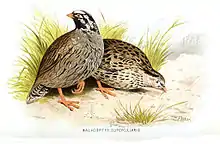Wildlife of India
India is home to a large variety of wildlife. It is a biodiversity hotspot with its various ecosystems ranging from the Himalayas in the north to the evergreen rainforests in the south, the desert sands of the west to the marshy mangroves of the east. India, lying within the Indomalayan realm, is home to about 7.6% of mammal, 14.7% of amphibian, 6% of bird, 6.2% of reptilian, and 6.0% of flowering plant species.[1] India's forest lands nurture about 500 species of mammals and 2000+ bird species. This richness of Indian wildlife has been celebrated since time immemorial. Four of India’s national symbols consist India’s mammals.
| Part of a series on the |
| Wildlife of India |
|---|
 |
India is one of the most biodiverse regions of the world and contains three of the world’s 36 biodiversity hotspots – the Western Ghats, the Eastern Himalayas, and the Indo-Burma hotspot.[2][3] It is one of the seventeen megadiverse countries. The country has seven Natural World Heritage sites, eleven Biosphere Reserves in the World Network of Biosphere Reserves and thirty seven Ramsar Wetlands.
In response to decrease in the numbers of wild animals, human encroachment and poaching activities, the government of India established a system of national parks and protected areas in 1935, which was subsequently expanded. In 1972, India enacted the Wildlife Protection Act and Project Tiger to safeguard crucial habitat. Further, federal protections were promulgated in the 1980s.
India has about 2,714 endemic Lichen species. In 2020, the Lichen Park in India was developed by the Uttarakhand Forest Department in Munsiyari.[4]
Geographic origins
Many Indian species are descendants of species originating in Gondwana, of which India originally was a part. Peninsular India's subsequent movement towards, and collision with, the Laurasian landmass set off a mass exchange of species. However, volcanism and climatic change 20 million years ago caused the extinction of many endemic Indian forms.[5] Soon thereafter, mammals entered India from Asia through two zoogeographical passes on either side of the emerging Himalaya.[6] As a result, among Indian species, only 12.6% of mammals and 4.5% of birds are endemic, contrasting with 45.8% of reptiles and 55.8% of amphibians[1] Notable endemics are the Nilgiri langur and the brown and carmine Beddome's toad of the Western Ghats. India harbours 172, or 2.9%, of IUCN-designated threatened species.[7] India is located at the junction of three realms namely Afrotropical, Indomalayan and Paleoarctic, and therefore, has characteristic elements from each of them, spurring migration of avifauna from these regions.
Fauna

India is home to several well-known large animals, including the Indian elephant,[8] Indian rhinoceros,[9] Bengal tiger,[10] Asiatic lion,[11] Indian leopard,[12] snow leopard,[13] and clouded leopard.[14]Bears include sloth bear, the Himalayan black bear, the Himalayan brown bear, and deer and antelopes include the chausinga antelope, the blackbuck, chinkara, chital, sambar (deer), Tibetan antelope, goa (antelope), Kashmir stag, and the barasinga. It is home to big cats like Bengal tiger and Indochinese tiger, Asiatic lion, Indian leopard, Indochinese leopard, snow leopard, and clouded leopard. Various species of caprines, including Bhutan and Mishmi takin, Himalayan and red goral, Himalayan serow, red serow, Himalayan tahr, and Nilgiri tahr, as well as the kiang and Indian wild ass can be found. Reptiles like king cobra, Indian cobra, Indian python, reticulated python, and gecko are common. Birds include Indian peacock, great Indian hornbill, painted stork, greater and lesser flamingo, and Eurasian spoonbill.[15][16]
Flora
There are about 18500 taxa of flowering plants from India. The Indian Forest Act, 1927 helped to improve the protection and security of the natural habitat. Many ecoregions, such as the shola forests, also exhibit extremely high rates of endemism; overall, 33% of Indian plant species are endemic.[17] Flora and Vegetation of forest cover ranges from the tropical rainforest of the Andaman Islands, Western Ghats, and Northeast India to the coniferous forest of the Himalaya. Between these extremes lie the sal-dominated moist deciduous forest of eastern India; teak-dominated dry deciduous forest of central and southern India, and the babul-dominated thorn forest of the central Deccan and western Gangetic plain.[6] Important Indian trees include the medicinal neem, widely used in rural Indian herbal remedies. Bamboo gardens are extremely common in jungles as well as villages. States like Sikkim and West Bengal have orchids. The national flower of India, the lotus flower, is common in lakes and ponds.
Fungi
The diversity of fungi and their natural beauty occupy a prime place in the biological world and India has been a cradle for such organisms. Only a fraction of the total fungal wealth of India has been subjected to scientific scrutiny and mycologists have to unravel this unexplored and hidden wealth. One-third of the fungal diversity of the globe exists in India. The country has an array of 10 diverse biomes including Trans-Himalayan zone, Himalaya, Desert, Semi-Arid zone, Western Ghats, Deccan Peninsula, Gangetic Plain, North-Eastern India, Coasts and Islands where varied dominating regimes manifest. This enables the survival of manifold fungal flora in these regions which include hot spot areas like the Himalayan ranges, Western Ghats, hill stations, mangroves, sea coasts, freshwater bodies etc. Many fungi have been recorded from these regions and from the country, in general, comprising thermophiles, psychrophiles, mesophiles, aquatic forms, marine forms, plant and animal pathogens, edible fungi and beneficial fungi and so on. The number of fungi recorded in India exceeds 27,000 species, the largest biotic community after insects. The true fungi belong to the Kingdom[18] Fungi which has four phyla, 103 orders, 484 families and 4979 genera. About 205 new genera have been described from India, of which 32% were discovered by C. V. Subramanian of the University of Madras.[19][20] These features indicate a tenfold increase in the last 80 years.
Conservation
Article 48 of the Constitution of India says, "The state shall endeavour to protect and improve the environment and to safeguard the forests and wildlife of the country" and Article 51-A states that "it shall be the duty of every citizen of India to protect and improve the natural environment including forests, lakes, rivers, and wildlife and to have compassion for living creatures."[21] The committee in the Indian Board for Wildlife, in their report, defines wildlife as "the entire natural uncultivated flora and fauna of the country" while the Wildlife (protection) Act 1972 defines it as "any animal, bees, butterflies, crustacea, fish, moths and aquatic or land vegetation which forms part of any habitat."[22]
Despite the various environmental issues faced, the country still has rich and varied wildlife.[22]
As of 2018-19, there are 870 protected areas including 104 National Parks, 551 Wildlife Sanctuaries, 88 Conservation Reserves and 127 Community Reserves covering a total of 1,65,088.57 km² of geographical area which is approximately 5.02% of the country. In addition there are 50 Tiger Reserves, 18 Biosphere Reserves and 32 Elephant Reserves.
Hundreds of India's bird populations are in serious decline, according to a study spanning over 25 years.[23]
In 2020 the Indian government created the world's first sea cucumber reserve in Lakshadweep-Dr KK Mohammed Koya Sea Cucumber Conservation Reserve, the largest marine conservation reserve - Attakoya Thangal Marine Conservation Reserve and the first protected area for marine birds in India - PM Sayeed Marine Birds Conservation Reserve.[24]
Extinctions in recent times

Gir forest in India has the only surviving population of Asiatic lions in the world. In the late 1960s, there were only about 180 Asiatic lions. There were 523 Asiatic lions in the Gir sanctuary in Gujarat state which in 2018 increased to more than 600.[25]
Some bird species have gone extinct in recent times, including the pink-headed duck (Rhodonessa caryophyllacea) and the Himalayan quail (Ophrysia superciliosa). A species of warbler, Acrocephalus orinus, known earlier from a single specimen collected by Allan Octavian Hume from near Rampur in Himachal Pradesh, was rediscovered after 139 years in Thailand.[26][27]
Cultural Influence
The varied and rich wildlife of India has had a profound impact on the region's popular culture. India's wildlife has been the subject of numerous tales and fables such as the Panchatantra or the Jataka Tales.
Notions of the wildlife of India were introduced in the west and also been made famous through The Jungle Book in late 1800s by Rudyard Kipling.
National animals

- National animal: Bengal tiger
- National heritage animal of India: Indian elephant
- National aquatic animal: South Asian river dolphin[28]
- National bird: Indian peacock
Biosphere reserves
The Indian government has established eighteen biosphere reserves of India which protect larger areas of natural habitat and often include one or more national parks and/or preserves, along buffer zones that are open to some economic uses. Protection is granted not only to the flora and fauna of the protected region, but also to the human communities who inhabit these regions, and their ways of life.
The protected areas are:
- Achanakmar Wildlife Sanctuary
- Agasthyamala Biosphere Reserve
- Dibru-Saikhowa National Park
- Dihang-Dibang Biosphere Reserve
- Great Nicobar Biosphere Reserve
- Gulf of Mannar Marine National Park
- Kutch Desert Wildlife Sanctuary
- Khangchendzonga National Park
- Manas National Park
- Nanda Devi National Park
- Nilgiri mountains
- Nokrek National Park
- Pachmarhi Biosphere Reserve
- Simlipal National Park
- Sundarbans National Park
- Cold Desert
- Seshachalam hills
- Panna National Park

Eleven of the eighteen biosphere reserves are a part of the World Network of Biosphere Reserves, based on the UNESCO Man and the Biosphere Programme (MAB) list.[29]
See also
- Birding in Chennai
- Birdwatchers' Field Club of Bangalore
- Endemic birds of the Andaman and Nicobar Islands
- India Nature Watch
- Indian Council of Forestry Research and Education
- List of birds of India
- List of mammals of India
- List of reptiles of South Asia
- Van Vigyan Kendra (VVK)
- Wildlife of Iran
- Wildlife of South Asia
- Wildlife Population of India
References
- Indira Gandhi Conservation Monitoring Centre (IGCMC), New Delhi and the United Nations Environmental Programme (UNEP), World Conservation Monitoring Centre, Cambridge, UK. 2001. Biodiversity profile for India
- Stephen, A., Suresh, R. Livingstone, C. (2015). "Indian Biodiversity: Past, Present and Future". International Journal of Environment and Natural Sciences. 7: 13–28.CS1 maint: multiple names: authors list (link)
- "CEPF.net - The Biodiversity Hotspots". www.cepf.net. Retrieved 5 March 2017.
- Timesnow news (28 June 2020). "India's 'first' lichen park in Uttarakhand to conserve Jurassic era plant". Retrieved 18 July 2020.
- K. Praveen Karach. (2006). Out-of-India Gondwanan origin of some tropical Asian biota
- Tritsch, M.E. 2001. Wildlife of India Harper Collins, London. 192 pages. ISBN 0-00-711062-6
- Groombridge, B. (ed). 1993. The 1994 IUCN Red List of Threatened Animals. IUCN, England, Switzerland and Cambridge, UK. lvi + 286 pp.
- Baskaran, N. & Desai, A. A. (1996). "Ranging behaviour of the Asian elephant (Elephas maximus) in the Nilgiri Biosphere Reserve, South India" (PDF). SSC Asian Elephant Specialist Group. 15: 41–57.
- Choudhury, A. U. (1985). "Distribution of Indian one-horned rhinoceros". Tiger Paper. 12 (2): 25–30.
- Jhala, Y. V.; Qureshi, Q.; Nayak, A. K. (2019). Status of tigers, co-predators and prey in India 2018. Summary Report. TR No./2019/05. New Delhi, Dehradun: National Tiger Conservation Authority & Wildlife Institute of India.
- Singh, H. S. & Gibson, L. (2011). "A conservation success story in the otherwise dire megafauna extinction crisis: The Asiatic lion (Panthera leo persica) of Gir forest" (PDF). Biological Conservation. 144 (5): 1753–1757. doi:10.1016/j.biocon.2011.02.009.
- Mondal, K.; Gupta, S.; Bhattacharjee, S.; Qureshi, Q. & K. Sankar (2012). "Prey selection, food habits and dietary overlap between leopard Panthera pardus (Mammalia: Carnivora) and re-introduced tiger Panthera tigris (Mammalia: Carnivora) in a semi-arid forest of Sariska Tiger Reserve, Western India". Italian Journal of Zoology. 79 (4): 607–616. doi:10.1080/11250003.2012.687402.
- Mishra, C. (1997). "Livestock depredation by large carnivores in the Indian trans-Himalaya: conflict perceptions and conservation prospects" (PDF). Environmental Conservation. 24 (4): 338–343. doi:10.1017/S0376892997000441.
- Choudhury, A. U. (1992). "The Clouded Leopard in Assam". Oryx. 27 (1): 51–53. doi:10.1017/s0030605300023966.
- "7 Rare and Exotic Wildlife Species that can be found in India".
- "Animals in Indian Sub-Continent".
- Botanical Survey of India. 1983
- Classification of Organisms Wikipedia Kingdom (biology)
- Fungal biodiversity: Distribution, conservation and prospecting of fungi from India
- Fungi of India 1989-2001 ;
- Krausman, PR & AT Johnson (1990) Conservation and wildlife education in India. Wild. Soc. Bull. 18:342-347
- Singh, Mahesh Prasad; Singh, J. K.; Mohanka, Reena (1 January 2007). Forest Environment and Biodiversity. Daya Publishing House. pp. 116–118. ISBN 9788170354215.
- https://www.independent.co.uk/environment/india-birds-decline-species-biodiversity-climate-crisis-a9342371.html
- Badri Chatterjee (29 February 2020). "World's first sea cucumber conservation area in Lakshadweep". Hindustan Times. Retrieved 23 July 2020.
- "India's endangered lion population increases to 600". m.phys.org. Retrieved 12 November 2019.
- Threatened birds of Asia Accessed October 2006
- The Nation, 6 March 2007
- Dolphin becomes India’s national aquatic animal
- UNESCO, Man and the Biosphere (MAB) Programme list
- SPECIES CHECKLIST: Species Diversity in India; ENVIS Centre: Wildlife & Protected Areas (Secondary Database); Wildlife Institute of India (WII)
- ENVIS Centre: Wildlife & Protected Areas (Secondary Database); Wildlife Institute of India (WII)
- Free EBOOK: Special Habitats and Threatened Plants of India; Wildlife Institute of India (WII)
- ENVIS Centre on Conservation of Ecological Heritage and Sacred Sights of India; ENVIS; C.P.R. Environmental Education Centre is a Centre of Excellence of the Ministry of Environment and Forests, Government of India. Home page
- Conservation of wetlands of India – a review by S.N. PRASAD1, T.V. RAMACHANDRA2, N. AHALYA2, T. SENGUPTA1, ALOK KUMAR1, A.K. TIWARI3, V.S. VIJAYAN1 & LALITHA VIJAYAN1; 1Salim Ali Centre for Ornithology and Natural History, Coimbatore 641108, 2Centre for Ecological Sciences, Indian Institute Of Science, Bangalore 560012, 3Regional Remote Sensing Service Centre, Dehradun, Uttaranchal 248001; Tropical Ecology 43(1): 173-186, 2002 ISSN 0564-3295; © International Society for Tropical Ecology. PDF
- ;Fungal biodiversity: Distribution, conservation and prospecting of fungi from India. By: C. Manoharachary, K. Sridhar, Reena Singh, Alok Adholeya, T. S. Suryanarayanan, Seema Rawat and B. N. Johri. CURRENT SCIENCE, VOL. 89, NO. 1, 10 JULY 2005. PDF
- ;Fungi of India 1989-2001. By: Jamaluddin, M.G. Goswami and B.M. Ojha, Scientific Publishers, 2004, vii, 326 p, ISBN 8172333544.
External links
- Official website of: Government of India, Ministry of Environment & Forests
- "Legislations on Environment, Forests, and Wildlife" from the Official website of: Government of India, Ministry of Environment & Forests
- "India's Forest Conservation Legislation: Acts, Rules, Guidelines", from the official website of the Government of India, Ministry of Environment & Forests
- Wildlife Legislations, including - "The Indian Wildlife (Protection) Act" from the Official website of: Government of India, Ministry of Environment & Forests
